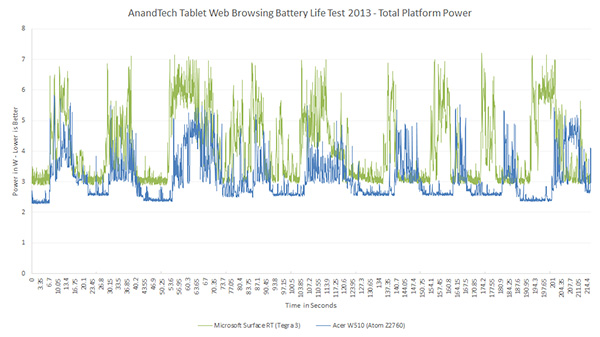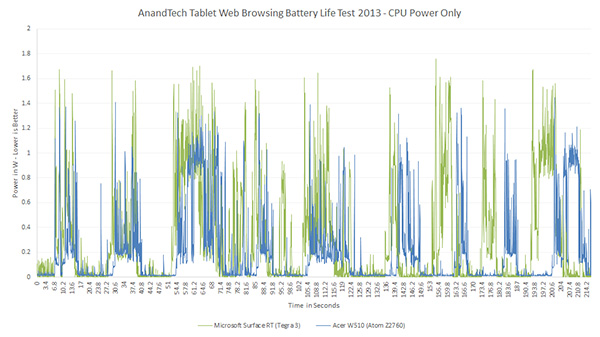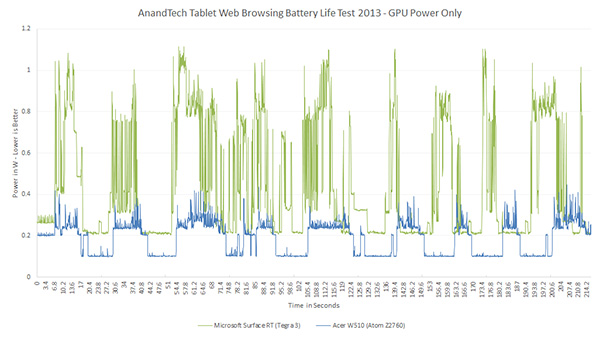The x86 Power Myth Busted: In-Depth Clover Trail Power Analysis
by Anand Lal Shimpi on December 24, 2012 5:00 PM ESTWireless Web Browsing Battery Life Test
For our final test I wanted to provilde a snippet of our 2013 web browsing battery life test to show what its power profile looked like. Remember the point of this test was to simulate periods of increased CPU and network activity, that could correspond to more than just browsing the web but interacting with your device in general.
Those bursts of power consumption are the direct result of our battery life test doing its job. That the tasks should take roughly the same time to complete on both devices, making this a good battery life test by not penalizing a faster SoC with more work.
Note that the W510's curve ends up lagging behind Surface RT's curve a bit by the end of the chart. This is purely because of the W510's garbage WiFi implementation. I understand that a fix from Acer is on the way, but it's neat to see something as simple as poorly implemented WiFi showing up in these power consumption graphs.
I always think about GPU power consumption while playing a game, but going through this experiment gave me a new found appreciation for non-gaming GPU power efficiency. Simply changing what's displayed on screen does burn an appreciable amount of power.













163 Comments
View All Comments
dangerjaison - Tuesday, December 25, 2012 - link
The only reason why arm could make this progress is bcoz of android and ios. They are built mainly to run on arm architecture. There are lots of issues mainly hardware acceleration in intel's architecture coz the developers build their games n apps to perform well on arm. The recently launches Intel device with atom running android had good backup and performance but couldn't succeed bcoz of compatibility. Intel still can make a big comeback to take over arm in mobile market.SilentLennie - Tuesday, December 25, 2012 - link
Euh... actually, everyone knew the NVidia product sucked on the power efficiency front.There is still a lot of work to do for Intel.
Blaster1618 - Tuesday, December 25, 2012 - link
One would think that Nvidia would have spent a couple of dollars to to work on their GPU efficiency. lolULP Geforce at 520 MHz in (40 nm) process easily beat a Power VR SGX545 (65 nm).
Even when when Nvida moves to (28 nm) technology next year it will move form a pig to a Pig-lite.
Another thought it is so Microsoft to make an ARM specific OS that does not support the 5th core on the Tegra 3.
CeriseCogburn - Friday, January 25, 2013 - link
Tegra4 is looking mighty fine, so whatever.Tegra3 was great when it came to gaming - it kept making Apple's best look just equal.
Microsoft may actually be the bloated pig syndrome company. I find it likely that the LP 5th tegra core wasn't enough to keep the fat msft pig OS running.
Of course it could just be their anti-competitive practice in full swing.
GillyBillyDilly - Tuesday, December 25, 2012 - link
but when I watch the power eaters on a Nexus 7, up to 90 percent is used up by display alone, which makes the cpu power efficiency somewhat seem irrelevant. Isn't it time to talk about display efficiency?CeriseCogburn - Friday, January 25, 2013 - link
Yep. Good point. No, great point, although it looks to be more like 40% for display power use on the new large screen mobile phones and phablets.shadi_h - Tuesday, December 25, 2012 - link
I really believe Microsoft missed a great opportunity to go forward with an Intel only CPU strategy (they already have the best development kits for x86). An Intel powered cellphone is what I really want! Maybe the RT version should have been Clover Trail w/ 32-bit and Pro w/ 64-bit. Their decision makes me believe they put too much emphasis getting easy app conversions from the iOS/Android communities and not creating the best hardware.jeffkibuule - Tuesday, December 25, 2012 - link
It's not such a great idea to hitch all of your hopes on Intel, they seem to only do their best work when they have a strong competitor.shadi_h - Tuesday, December 25, 2012 - link
True but that's not anyone's fault but AMD. it seems they have no clue how to even enter this space. That's puzzling since it can be argued they potentially could have the best overall SoC tech (thought that was the whole reason they bought ATI in the first place).Powerlurker - Wednesday, January 2, 2013 - link
AMD dumped their mobile lineup in 2008 and sold it to Qualcomm (now known as Adreno) and sold their STB lineup (Xilleon) to Broadcom. Anything they could have used is gone at this point.